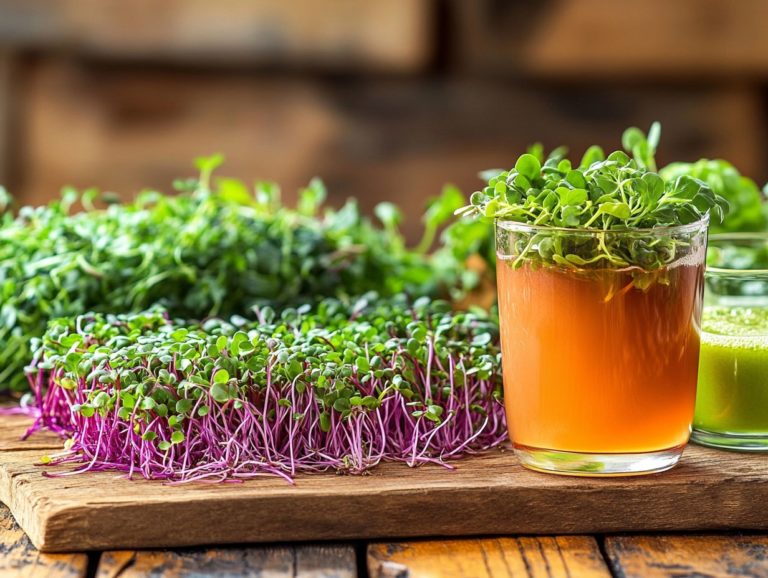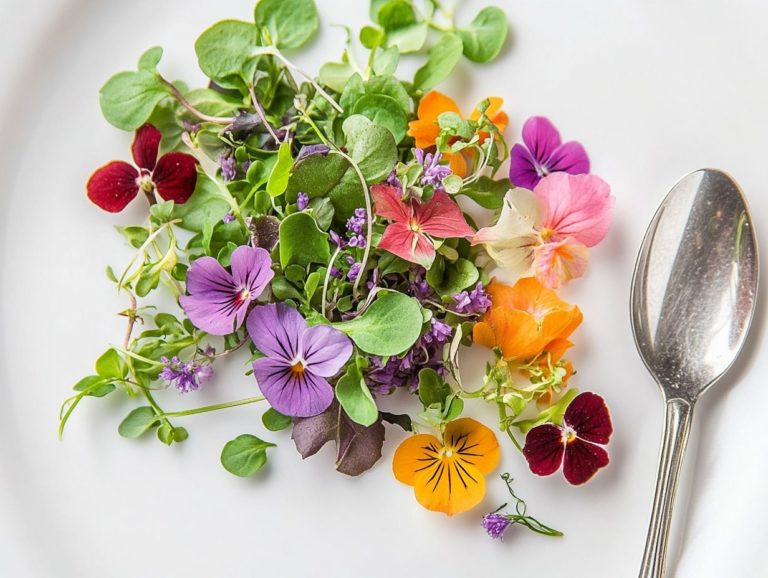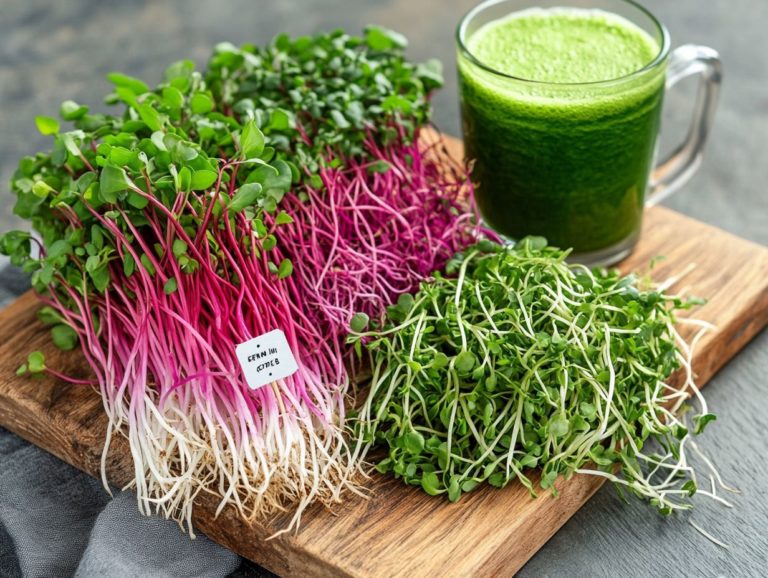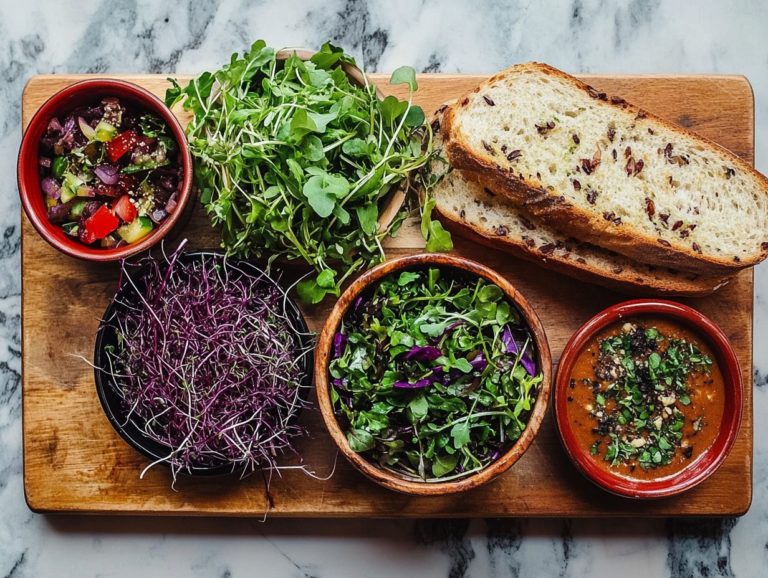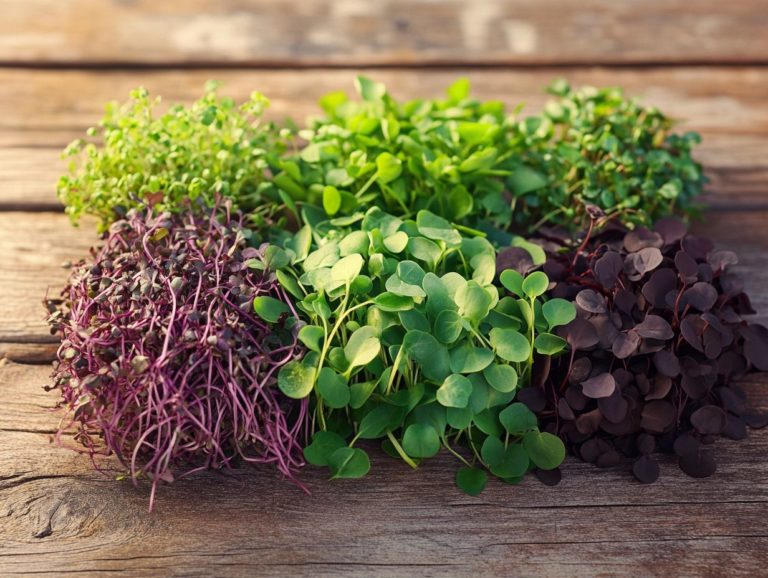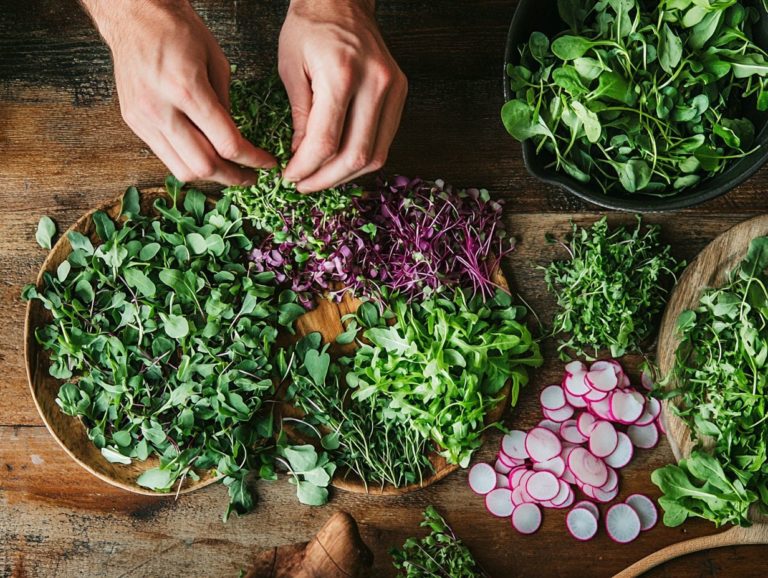Top Microgreen Varieties for Fresh Spring Rolls
Microgreens are vibrant, nutrient-rich foods that can elevate any dish, including spring rolls with peanut sauce.
Discover the best microgreen varieties to enhance your spring roll experience, featuring radish and basil microgreens.
Learn how to grow these greens at home, with expert tips for cultivation and harvesting. Explore their amazing health benefits!
Get ready to transform your meals with delightful, crunchy toppings!
Contents
- Key Takeaways:
- 1. Radish Microgreens
- 2. Cilantro Microgreens
- 3. Sunflower Microgreens
- 4. Pea Microgreens
- 5. Beet Microgreens
- 6. Basil Microgreens
- 7. Arugula Microgreens
- 8. Mustard Microgreens
- 9. Broccoli Microgreens
- 10. Kale Microgreens
- 11. Chia Microgreens
- 12. Amaranth Microgreens
- 13. Wheatgrass Microgreens
- 14. Dill Microgreens
- 15. Fennel Microgreens
- What Are Microgreens and Why Are They Great for Spring Rolls?
- Frequently Asked Questions
- What are the top microgreen varieties for fresh spring rolls?
- Why are these microgreens the best for fresh spring rolls?
- Are there any other microgreens that work well in fresh spring rolls?
- Which microgreens provide a spicy kick to spring rolls?
- Can I mix and match different microgreen varieties in my spring rolls?
- Where can I purchase these microgreen varieties for my spring rolls?
Key Takeaways:
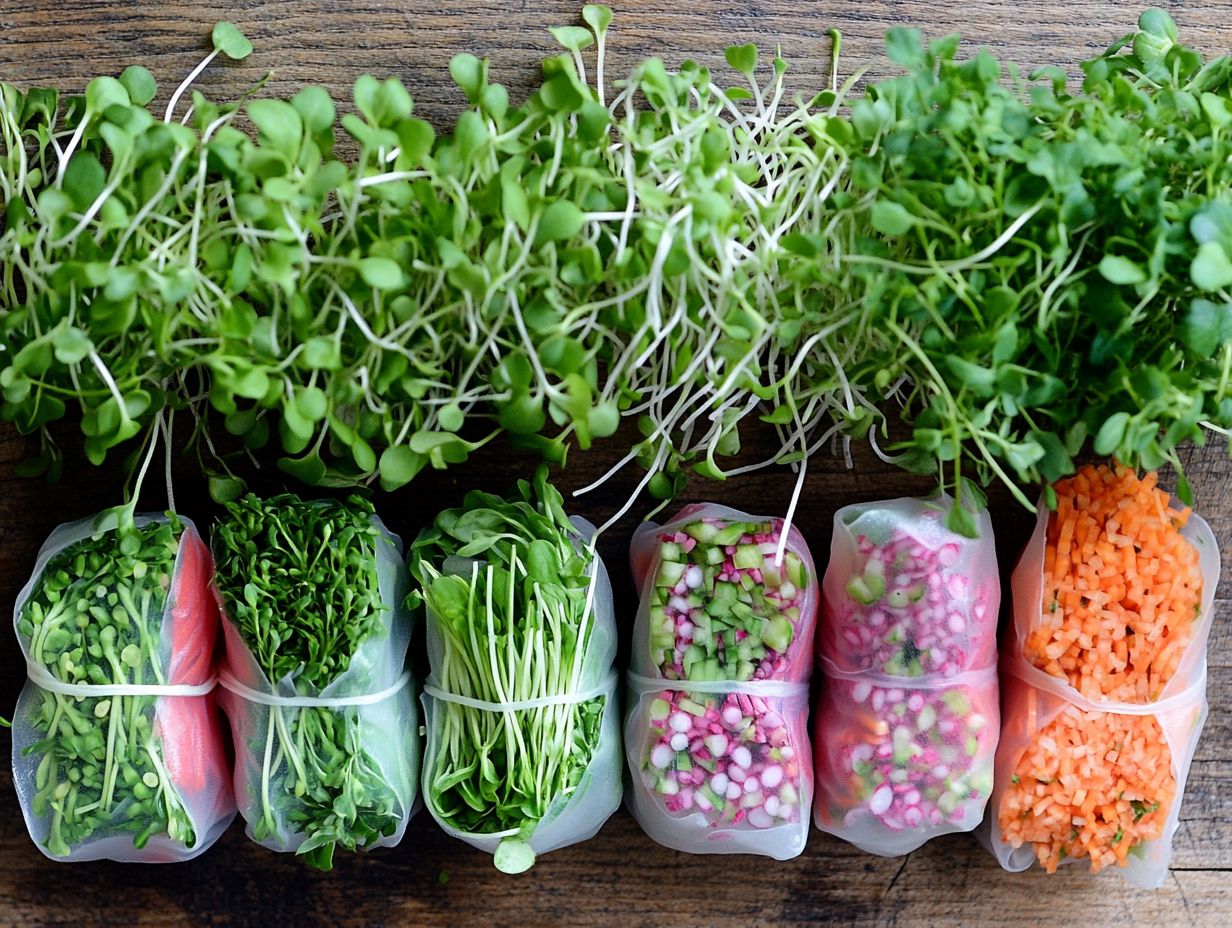
- Radish, cilantro, and sunflower microgreens add a refreshing crunch and burst of flavor to spring rolls.
- Pea, beet, and basil microgreens offer a sweet and earthy taste, balancing the flavors in a spring roll.
- Arugula, mustard, and broccoli microgreens provide a peppery kick, adding depth to spring rolls.
1. Radish Microgreens
These vibrant microgreens are easy to grow and a fantastic addition to any garden.
Radish microgreens are nutritious and charming, perfect for any home garden. They re a great choice for anyone eager to grow flavorful greens at home.
With a delightful peppery taste, radish microgreens enhance the flavor of dishes while offering vitamins A, C, and E, plus essential minerals like calcium and magnesium.
To grow these greens, use a well-drained seed-starting mix and plenty of light, either from the sun or a grow lamp.
They thrive in temperatures between 60 F and 75 F. Water them regularly to keep the soil moist, avoiding over-watering.
After harvesting, sprinkle them on salads, toss them in sandwiches, or blend them in smoothies for a delightful crunch and color.
2. Cilantro Microgreens
These flavorful microgreens are a favorite in home gardens.
Cilantro microgreens are aromatic and packed with health benefits. They re beloved by culinary enthusiasts and health-conscious individuals.
These greens add a burst of flavor to tacos, salads, and soups. They also bring visual appeal, transforming ordinary meals into gourmet masterpieces.
Growing cilantro microgreens is simple: all you need are seeds, a growing medium, and light. In a few weeks, enjoy fresh greens that enhance flavor and provide significant nutritional benefits.
These microgreens make a perfect finishing touch, adding zest and a pop of color to your meals.
3. Sunflower Microgreens
Sunflower microgreens are a delightful addition to any home gardening project, known for their crunchy texture and impressive nutritional profile, which includes essential vitamins and minerals.
To cultivate these vibrant greens, ensure they receive plenty of sunlight ideally around 12 to 16 hours each day while maintaining a consistent moisture level in well-draining soil. Ideal temperatures hover between 65 and 75 F, promoting optimal growth.
Throughout their growth cycle, which typically spans 7 to 14 days, be mindful to avoid overcrowding the seeds; giving each microgreen enough space is essential for thriving.
You ll want to try adding them to your meals right away! Packed with vitamins A, C, and E and essential amino acids, these tiny powerhouses can enhance salads or serve as eye-catching garnishes on a variety of dishes, boosting both flavor and visual appeal.
4. Pea Microgreens
Pea microgreens are easy to grow and brimming with essential nutrients, making them an excellent addition to any health-conscious diet.
They thrive in rich, well-drained soil and need ample light to reach their full flavor potential. With a delicate sweetness that complements numerous dishes, these tiny greens offer a fantastic source of vitamins A, C, and K along with antioxidants that support overall health.
You can easily add them to your meals and impress your guests! Whether you sprinkle them atop salads, blend them into s smoothies, or use them as a vibrant garnish for soups, their unique taste elevates flavors in both savory and sweet recipes.
5. Beet Microgreens
Beet microgreens are a vibrant and nutritious choice for your meals, known for their great taste and impressive nutrient profile.
These petite greens sprout from beet seeds, flourish in soil, and take up minimal space, making them ideal for urban gardeners and those with limited resources.
Their flavor dances on the palate with a subtle sweetness and earthy undertones, elevating salads, sandwiches, and smoothies alike.
For harvesting, aim to cut them just above the soil level once they’ve reached about 1-2 inches in height; this ensures they remain fresh and lively.
Rich in vitamins A, C, and K, beet microgreens can significantly enhance your diet while delivering antioxidant benefits.
Start your microgreen garden today and enjoy fresh flavors right at home! Whether you sprinkle them into a colorful grain bowl or use them as a garnish on a steaming bowl of soup, their striking red and green hues will make your dishes not only visually stunning but also utterly delicious.
6. Basil Microgreens
Basil microgreens are a fragrant and versatile gem. They elevate the flavor of your dishes and bring many health benefits.
These tiny greens deliver a concentrated burst of basil’s signature sweet and peppery taste, enhancing everything from salads to sandwiches and even pasta dishes. Want to grow these microgreens? Just remember: plenty of light and moisture equals a bountiful harvest!
Packed with essential vitamins and minerals, basil microgreens support your immune function and overall health. Their delicate leaves can be seamlessly integrated into various recipes, whether garnishing soups or infusing oils, making every meal a touch more delightful.
With the right techniques, cultivating basil microgreens can transform into a rewarding and enjoyable journey, enriching your cooking along the way.
7. Arugula Microgreens

Arugula microgreens bring a delightful peppery flavor along with a wealth of health benefits, making them an excellent choice for anyone looking to elevate their culinary ventures.
These petite greens thrive in soil that drains well. Keep them in a warm spot for best results and provide around 12 to 16 hours of light each day. Their rapid growing cycle of just 7 to 14 days allows for quick harvesting, ensuring a fresh and nutritious addition to your meals.
Packed with vitamins A, C, and K, arugula microgreens not only bolster immune function but also deliver a vibrant burst of flavor and texture to salads, sandwiches, and an array of dishes. Incorporating them into your cooking makes them an essential element for any modern kitchen.
8. Mustard Microgreens
Mustard microgreens are a breeze to grow and offer a zesty kick, making them an excellent addition to your home gardening collection.
These vibrant greens flourish in a well-drained soil mix and need only a touch of sunlight, making them perfect for indoor gardening. Their peppery flavor can elevate a range of dishes from salads to sandwiches providing a delightful contrast to milder ingredients.
Packed with vitamins A, C, and K, along with a wealth of antioxidants, mustard microgreens not only boost your immunity but also promote healthy skin. To make the most of these delightful greens, consider sprinkling them over soups, blending them into smoothies, or tossing them with roasted vegetables for a refreshing twist.
9. Broccoli Microgreens
Broccoli microgreens are your ticket to a health boost and effortless growth, making them a favored choice for those looking to elevate their diet with nutrient-rich greens.
These petite, leafy wonders deliver a flavor that s both slightly peppery and refreshingly vibrant, transforming your meals into culinary masterpieces while packing a remarkable array of vitamins, minerals, and antioxidants.
Cultivating these nutritious microgreens is a breeze; all you need is a shallow tray, quality soil, and a touch of careful watering, and they will flourish whether indoors or outdoors.
When the time comes to harvest microgreens typically within 7 to 14 days you’ll find that these microgreens can enhance salads, sandwiches, and smoothies alike. Start your microgreens journey today for a fresh, healthy boost to your meals!
10. Kale Microgreens
Kale microgreens, along with other varieties from the Brassica family, are a great source of nutrition, brimming with vitamins and minerals. They are an exceptional choice for anyone eager to incorporate easy-to-grow greens into their diet.
These vibrant greens thrive in a range of conditions and truly flourish in well-drained soil with ample sunlight. Ideally, they soak up about 12 to 16 hours of light each day. Their unique flavor strikes a perfect balance between a mildly peppery kick and a hint of sweetness, making them a versatile addition to many dishes.
Rich in vitamins A, C, and K, along with antioxidants and fiber, kale microgreens offer numerous health benefits. They help boost your body’s defense system and support heart health. Whether you sprinkle them atop salads, blend them into smoothies, or nestle them into sandwiches, these microgreens elevate both flavor and nutrition, making them a great addition to dishes featuring cabbage microgreens and Brussels sprouts.
Start growing them today for a healthier meal!
11. Chia Microgreens
Chia microgreens present a unique and nutritious option for home gardening enthusiasts. They offer a rich source of essential nutrients and are remarkably easy to cultivate, just like carrot microgreens and kohlrabi microgreens.
These tiny greens deliver a delightful burst of flavor and texture to your dishes. They are packed with vitamins, minerals, and antioxidants that support overall health. With the rising interest in plant-based diets, you’ll discover the myriad health benefits of incorporating these greens into your meals, including Tokyo Bekana and Wasabina mustard greens.
Chia microgreens enhance digestion and boost heart health. Whether you sprinkle them atop salads, blend them into smoothies, or use them as a garnish for soups, these microgreens elevate the nutritional profile of your meals and add a vibrant touch.
Start growing them today for a healthier meal!
12. Amaranth Microgreens
Amaranth microgreens are not just a feast for the eyes; they are also brimming with essential nutrients. This makes them a splendid addition to your health-focused garden.
Their vibrant hues and delicate leaf structures make them a favored choice for gardeners of any skill level. They pair beautifully with other varieties like cabbage and cauliflower microgreens.
These tiny greens are packed with vitamins A, C, and K, along with crucial minerals like calcium, iron, and magnesium. Growing them is straightforward; they flourish in various soils and demand minimal maintenance, just like microgreen seeds.
Once harvested, these microgreens can elevate a variety of dishes from fresh salads and wraps to garnishes on soups and entrees. They infuse your meals with flavor and provide a nutritious boost.
Start growing them today for a healthier meal!
13. Wheatgrass Microgreens
Wheatgrass microgreens, alongside carrot microgreens, are celebrated for their impressive health benefits and vibrant green hue. They are an ideal choice for anyone looking to cultivate nutritious microgreens at home.
These little powerhouses are brimming with vitamins A, C, and E, along with essential minerals that naturally enhance your body’s defense system. Cultivating wheatgrass microgreens is refreshingly simple and perfectly suited for small spaces; all you need is soil, water, and light.
Once harvested, these microgreens become a delightful addition to juices and health drinks. They offer a fresh flavor paired with an energizing nutrient boost. Incorporating wheatgrass microgreens into your daily diet has become a popular strategy among health enthusiasts, showcasing their remarkable versatility across recipes.
Start growing them today for a healthier meal!
14. Dill Microgreens
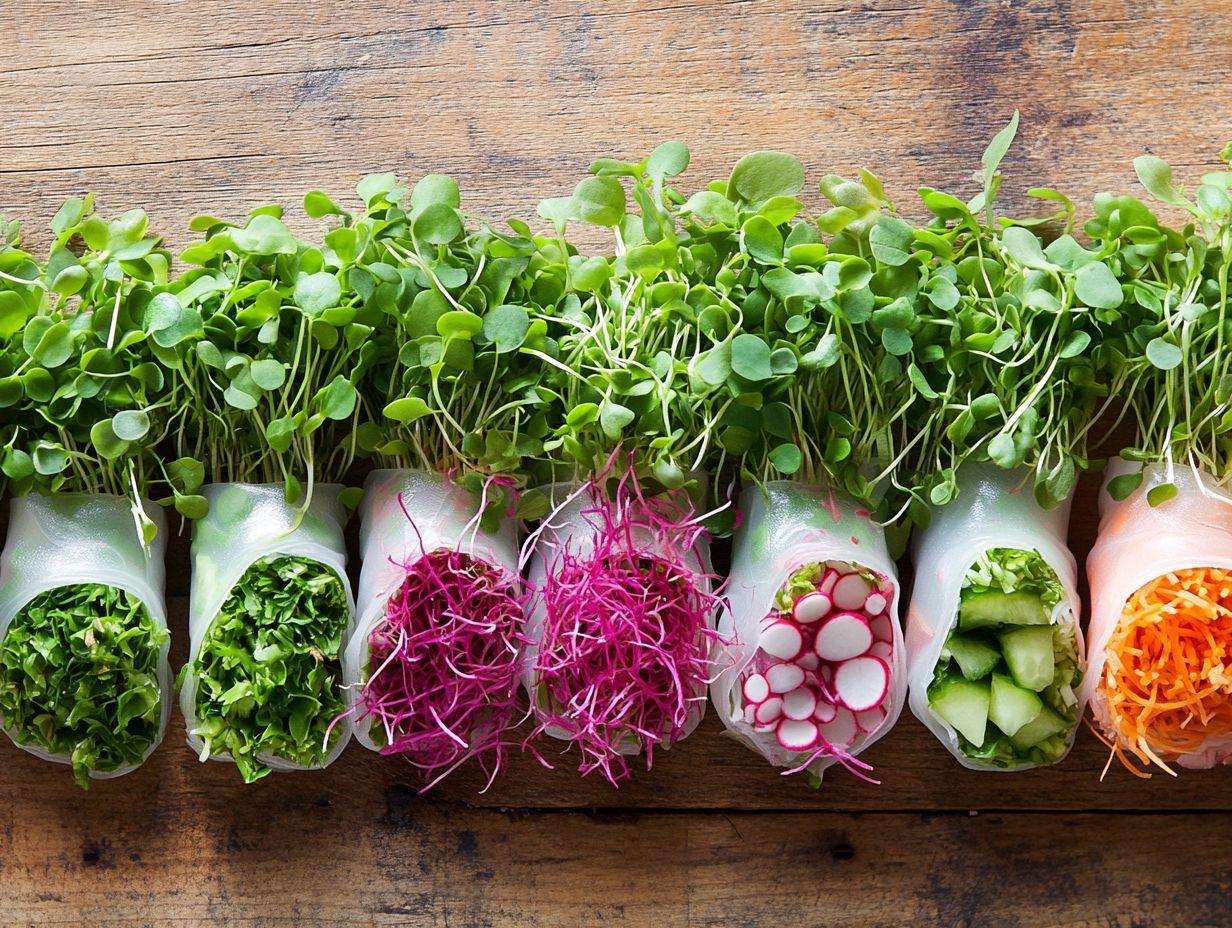
Dill microgreens bring a fresh, aromatic flair to your dishes while offering a wealth of health benefits. They are a must-have in your microgreens garden.
These delicate greens are brimming with essential vitamins and nutrients, significantly enhancing the nutritional profile of your meals. With their vibrant green hue and distinct anise-like flavor, they effortlessly elevate a variety of culinary creations from crisp salads and hearty soups to exquisite seafood dishes and gourmet sandwiches.
Their ability to enhance many dishes is truly remarkable. Sprinkle them on appetizers or blend them into dressings and dips for a layer of complexity that tantalizes the taste buds. Pair them with harvest microgreens or others from the Brassica family for a delightful experience.
15. Fennel Microgreens
Fennel microgreens are a distinctive culinary gem, celebrated for their anise-like flavor and impressive health benefits. They make an exquisite enhancement to your home-cooked meals, much like cabbage microgreens and kohlrabi microgreens.
These tender sprouts offer a burst of aromatic essence and introduce a vibrant green hue to your dishes, captivating both the palate and the eye. You can easily grow these on a windowsill or in a garden, harvesting them within just two weeks.
Their subtle sweetness and aromatic notes elevate salads, soups, and seafood dishes, transforming everyday recipes into gourmet delights. Use them as a garnish to enhance visual appeal and add a refreshing crunch that complements many cuisines.
What Are Microgreens and Why Are They Great for Spring Rolls?
Microgreens, including varieties such as Brussels sprouts and Red Russian kale, are the young seedlings of edible vegetables and herbs. They are brimming with flavor and nutrients, making them the perfect secret weapon for elevating dishes like spring rolls.
These tiny powerhouses come in various types think radish, basil, cilantro, and mustard greens, including carrot and kohlrabi each offering its unique taste along with a treasure trove of vitamins, minerals, and antioxidants. If you’re curious about the best options, check out the most versatile microgreens. Their outstanding nutritional profiles can give your overall health a boost, helping to support immune function and reduce inflammation.
When you add microgreens to your spring rolls, you’re not just incorporating freshness; you’re also enhancing texture and visual appeal. For the best results, consider mixing different microgreens, such as Brassica family varieties, to create a delightful blend of flavors. For inspiration, check out the top microgreen varieties for gourmet cooking. Toss them lightly with a drizzle of sesame oil and a splash of soy sauce before wrapping.
This simple yet effective approach results in a satisfying crunch that elevates your dish to new heights, transforming your culinary experience into something truly delightful.
How Can One Grow Microgreens at Home?
Growing microgreens, including cabbage and carrot microgreens, at home is an incredibly straightforward process that requires minimal space and effort. This makes it a highly accessible gardening option for anyone looking to incorporate fresh, nutritious greens into their diet.
To embark on this rewarding endeavor, you don t need a green thumb or a sprawling outdoor space. With just a few essential supplies, including microgreen seeds, you can cultivate a delightful array of flavors and colors right in your kitchen.
- Get trays, quality potting soil, and a spray bottle for watering including supplies for Home Microgreens.
- Next, carefully select your seeds. Varieties like cabbage, arugula, radish, or broccoli are perfect, as they thrive beautifully in microgreen conditions.
Ensuring adequate light, maintaining the right moisture levels, and promoting good air circulation are vital to your success. Regularly monitor your greens and avoid overwatering to keep them healthy and vibrant. For a fresh twist, consider which microgreens are best for salads; before you know it, you’ll be ready to enjoy a bountiful harvest of quick-to-grow microgreens in just a couple of weeks.
What Are Some Tips for Harvesting and Storing Microgreens?
Harvesting and storing microgreens correctly is crucial for keeping them fresh and retaining their health benefits. This way, you can enjoy their vibrant flavors and nutrients for longer, including those from Home Microgreens.
To know when to harvest microgreens, wait until the seedlings show their first real leaves. This typically happens between 7 to 21 days after sowing, depending on the variety, like carrot or kohlrabi. This timing ensures peak flavor and a better nutrient profile.
When you’re ready to harvest, use sharp scissors or a knife to cut them just above the soil line. This technique reduces root damage and supports future growth, especially for varieties like Brussels sprouts microgreens.
After harvesting, gently rinse the microgreens to remove any dirt, then pat them dry with a clean towel. For the best storage, place them in a breathable container in the refrigerator. This method keeps them crisp and flavorful while preserving essential vitamins and minerals. It ensures a delightful experience, especially with varieties like cabbage microgreens.
Proper storage not only extends the shelf life of these delicate greens but also makes sure they remain a nutritious addition to your meals, keeping those vibrant bursts of flavor intact.
How Can Microgreens Be Used in Other Dishes Besides Spring Rolls?
Microgreens are a culinary treasure that can elevate your dishes beyond just the humble spring roll. They add color, flavor, and significant health benefits to salads, sandwiches, and soups, making them essential in your kitchen.
By incorporating microgreens into your meals, you enhance their visual appeal and infuse your dishes with a nutritional powerhouse. These tiny greens are loaded with vitamins, minerals, and antioxidants. For a bold kick, toss some spicy arugula microgreens into a mixed salad or layer them in your sandwich for an added flavor and crunch. To discover even more options, check out the best microgreen varieties for beginners. They also work great as a garnish for soups, bringing a refreshing quality and an aromatic touch.
If you’re seeking a simple way to boost your daily nutrient intake, blend microgreens into your smoothies. They not only enhance the flavor profile but also add a bright, refreshing twist to your beverages. For insights on choosing the best options, check out top microgreen varieties for health.
What Are the Nutritional Benefits of Microgreens?
Microgreens are a treasure trove of essential nutrients, offering higher concentrations of vitamins, minerals, and antioxidants compared to mature vegetables. They are a fantastic addition to any health-conscious diet.
These petite greens are harvested just after their first true leaves emerge. They come packed with an impressive array of vitamins, including C, E, and K. These vitamins are crucial for maintaining skin health, boosting immunity, and supporting strong bones. Additionally, microgreens are rich in various antioxidants that combat oxidative stress, potentially reducing the risk of chronic diseases. If you’re curious about the best options for adding flavor and nutrition, check out what are the best microgreens for sandwiches.
When compared to mature vegetables, microgreens can contain up to 40 times the concentration of certain nutrients, such as vitamins C and E. This simple yet powerful addition can enhance your overall wellness and elevate the nutritional quality of your meals.
Frequently Asked Questions
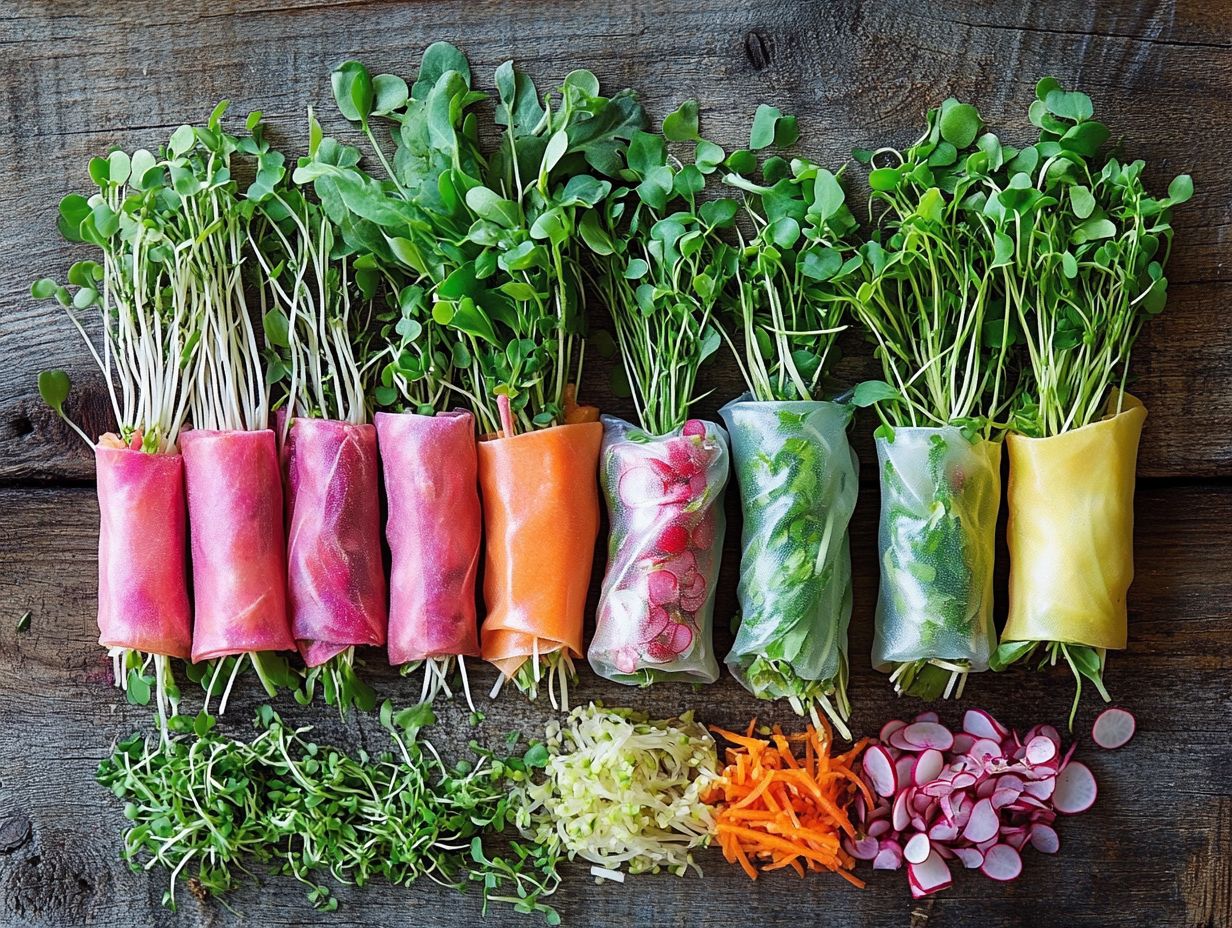
What are the top microgreen varieties for fresh spring rolls?
The top microgreen varieties for fresh spring rolls include radish, pea shoots, cilantro, sunflower, mustard, and basil.
Why are these microgreens the best for fresh spring rolls?
These microgreens are the best for fresh spring rolls because they contribute a burst of flavor, nutritional value, and vibrant color to the dish.
Are there any other microgreens that work well in fresh spring rolls?
Yes, other microgreens that work well in fresh spring rolls include broccoli, kale, watercress, and chives.
Which microgreens provide a spicy kick to spring rolls?
Mustard and radish microgreens provide a spicy kick to spring rolls, making them perfect for those who enjoy a little heat in their food.
Can I mix and match different microgreen varieties in my spring rolls?
Absolutely! Experimenting with different microgreen combinations is part of the fun of making fresh spring rolls. Balance the flavors to create a delicious and well-rounded dish.
Where can I purchase these microgreen varieties for my spring rolls?
Grab these vibrant microgreens at your local farmers market.
You can also find them in specialty grocery stores or even grow them yourself at home for a fresh twist!

